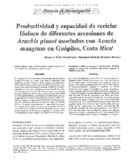Productividad y capacidad de reciclar fósforo de diferentes accesiones de Arachis pintoi asociados con Acacia mangium en Guápiles, Costa Rica
ISSN
1022-7482Fecha de publicación
2001Tipo
Artículo
Metadatos
Mostrar el registro completo del ítemTítulo alternativo
Productivity of different accessions of Arachis pintoi and their capacity to recycle P in association with Acacia mangium in Guapiles, Costa Rica
Descripción
4 ilus. 1 tab. 7 ref.
Resumen
En una plantación del maderable Acacia mangium de tres años, en Guápiles, Provincia de Limón, Costa Rica, se estudiaron siete accesiones de maní forrajero (Arachis pintoi) para determinar cuales tenían mayor potencial para reciclar fósforo (P). Las fracciones P inorgánico/membrana, P inorgánico/NaHCO3 y P orgánico/NaHCO3, y el P total en el suelo, no presentaron diferencias bajo las accesiones de A. pintoi. El número de esporas de micorriza por 100 g de suelo fue de 273 y 715 para las accesiones CIAT 18744 y 22159, respectivamente y el porcentaje de colonización de las raíces por micorrizas vesículo arbusculares fue superior a 80 por ciento en todas las accesiones. Las accesiones CIAT 18744 y 22150 tuvieron los mayores contenidos foliares de los elementos Mg, P y Zn (8866, 2400 y 53.58 mg kg-1, respectivamente). La producción de materia seca forrajera de A. pintoi, a los seis meses de siembra, fue mayor a una distancia de 4.5 m de los árboles (sin diferencia entre accesiones en productividad forrajera por parcela). La accesión CIAT 17434 presentó la mayor longitud específica de raíz (74 cm mg-1). In a 3 year old plantation of the timber tree Acacia mangium, in Guapiles, Limon Province, Costa Rica, seven different accessions of the fodder species Arachis pintoi were studied in order to identify those with the greatest potential to recycle P. Soil fractions P inorganic/membrane, inorganic P extracted by sodium bicarbonate and organic P extracted by sodium bicarbonate showed no significant differences below the different accessions of A. pintoi. The number of mycorrhizal spores found per 100g of soil were 273 and 715 for the accessions CIAT 18722 and 22159, respectively, and the percentage colonization of roots by vesicular arbuscular mycorrhizae was greater than 80 percent in all accessions. The accessions CIAT 18744 and 22150 had the highest values for foliar nutrient content of the elements Mg, P and Zn (8866, 2400 and 53.58 mg kg-1, respectively). Six months after planting the production of fodder dry matter was greatest at 4.5 m distance from the trees (there was no difference between the different accessions in forage productivity per plot). The accession CIAT 17434 had the highest value for specific root length (74 cm mg-1).
Palabras clave
Editor
CATIE, Turrialba (Costa Rica)


